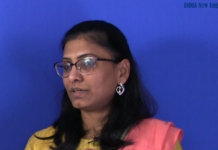WASHINGTON, DC—Indian Ambassador to the United States Harsh Vardhan Shringla said that there are more than half a million Indian students studying abroad, with USA as the most favored destination.
He said more than two hundred thousand Indian students are currently pursuing their higher studies in the Unites States. UK, Australia, Canada are other choice destinations for Indian students.
Speaking at the Education Promotion Society of India (EPSI), a not for profit organization from India, Mr. Shringla said the Indian education system is vast in size, as well as its academic offerings.
“However, it is important to note that for half a million students studying aboard, there are more than 30 million students pursuing higher education in India. The Indian Education system is the world’s third largest Higher Education System with 907 universities, 43,000 colleges and a capacity of enrolling more than a whopping 30 million students,” Mr. Shringla said his speech. “Higher Education Institutions in India offer courses/degrees that are competitive in the world market in terms of quality but are delivered at one-fourth the cost.”
He said a vibrant and diverse education system means a wide variety of courses are available: from the modern and cutting edge to the traditional.
“Indian education ranges from exposure to the latest advancements of science and technology like Virtual and Augmented Reality, Artificial Intelligence and Cognitive Computing to Yoga, Ayurveda, Sanskrit, languages, and classical music and dances,” said Mr. Shringla. “This vastness of the Indian education system directly translates to enhanced opportunities for its students and global learning for an all-round academic and personal development.”
He said a burgeoning IT and Services sector has led to a robust placement oriented education as about 200 of the Fortune 500 companies hire regularly from Indian campuses. India has been and continues to be home to innovation, creativity and leadership.
“The strength of India’s education system may be gauged from the fact that the world’s leading companies are being led by students of Indian education system,” said Mr. Shringla, giving examples that Satya Nadella, CEO, Microsoft is an alumni of Manipal Academy of Higher Education; Sundar Pichai, CEO, Google Inc studied at Indian Institute of Technology, Kharagpur; Ajaypal Singh Banga, President and the CEO, MasterCard, is graduate from St Stephen’s College, Delhi University; Rajeev Suri, CEO of Nokia has studied in Manipal Academy of Higher Education; and Indira Nooyi, CEO of Pepsi Co is an alumnus of Indian Institute of Management, Calcutta.
“Some of the leading world leaders and diplomats have graduated from Indian colleges and universities. Aung San Suu Kyi, incumbent state counsellor of Myanmar, Hamid Karzai former President of Afghanistan, William Kwasi Akuffo former Head of the State of Ghana, Olusegun Obasanjo former President of Nigeria, John Samuel Malecela former PM of Tanzania are few examples,” Mr. Shringla said.
Mr. Shringla also said that India witnessed its best phase of macro-economic stability in the past five years.
“From being the 11th largest economy in the world in 2013-14, we are heading to become fifth largest economy in the world by end of this year. In Purchasing Power Parity terms, today, India is the third largest economy in the World, after China and USA,” Mr. Shringla said. “India is poised to become a Five Trillion Dollar Economy in the next five years and aspires to become a Ten Trillion Dollar Economy in the next 8 years thereafter. Due to a stable and predictable regulatory regime, growing economy and strong fundamentals, India could attract massive amount of Foreign Direct Investment (FDI) during the last 5 years – as much as $239 billion. This period also witnessed a rapid liberalisation of the FDI policy, allowing most FDI to come through the automatic route. The last five years also witnessed a wave of next generation structural reforms, which have set the stage for decades of high growth.”
He said India also enjoys a distinct demographic advantage.India’s demographic cycle is about 10-30 years behind that of the other countries, indicating that the next few decades present an opportunity for India to catch up to their per capita income levels.
“India will be the world’s youngest country by 2025 with 985 million people in the workforce. (That is, people in the age group of 15-64 years),” Mr. Shringla said.
















